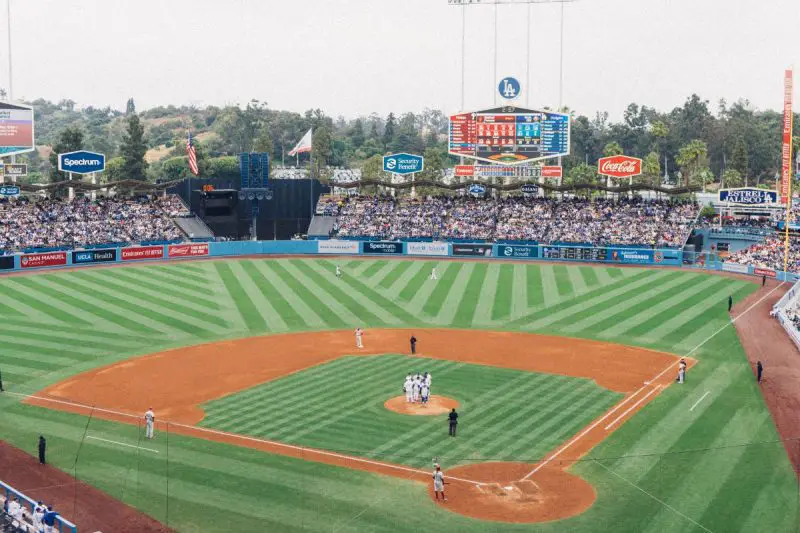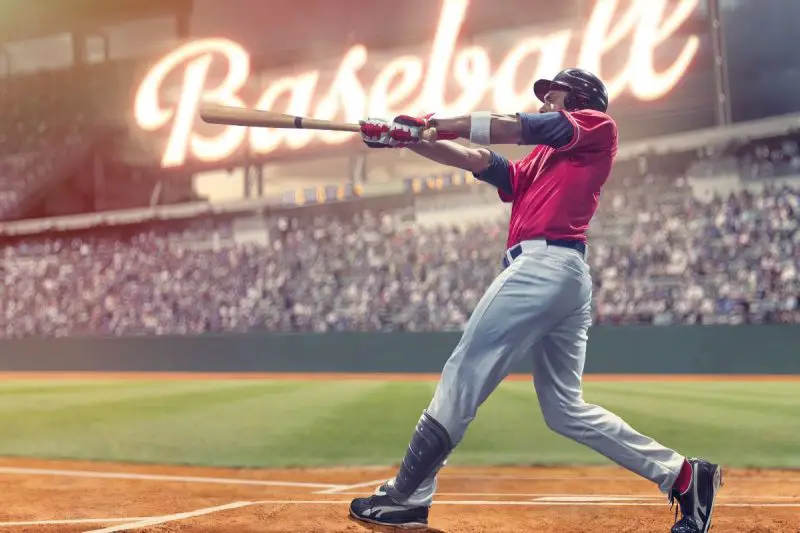Home plate is the center of the action on every baseball field, and it has a big impact on almost every aspect of the game, from how players approach the batter’s box to what kind of pitches they can expect to see.
Wondering just how wide a home plate has to be? Well, we have the answers that you need; read on for all you need to know!
What Is A Home Plate?
Home plate is a term and feature that appears in baseball, and refers to the area where the pitcher stands when he delivers his pitch to the batter.
The batter then steps into the batter’s box, which is marked by two parallel lines called the foul line and the baseline.
The pitcher must stand between these two lines while delivering the ball. If the pitcher crosses over either line, he will be ejected from the game.
The width of the home plate is typically a 17-inch wide square of rubber, but this is adapted to create a distinctive home plate shape.
The corners are removed, and one edge is left at 17 inches in length, with two sides at 8.5 inches each, and the remaining two sides at 12 inches.
These last two sides angle in towards one another, forming a point at the back.
Why Does It Matter How Big A Baseball Field Is?

A baseball field is measured by its dimensions, or size. There are four main measurements:
- Length – This is the distance from the home plate to first base.
- Width – This is the distance across the diamond from the home plate to third base.
- Height – This is the distance up from the ground to the top of the fence.
- Depth – This is the distance down from the top of the fence to the bottom of the dugout.
These measurements determine how much space there is around the bases, as well as how far away the outfielders can run.
For example, if the field is 50 feet long, and 10 feet deep, the outfielders would be able to cover an additional 30 feet beyond the fences.
If the field is too small, the outfielders may not be able to get balls hit out of play, and the batters may not be able to reach balls hit into the infield.
What Is Baseball?
Baseball is a sport played between two teams of nine players each. Each team takes turns batting against the other, and the objective is to score more runs than your opponent.
To do so, you’ll need to make contact with the ball using your bat, and try to hit it past the opposing team’s fielder.
You can also attempt to steal bases, and even throw the ball to runners who are trying to advance.
Baseball in its current form has been around since the Civil War period and is believed to be based on rounders, a classic game popular in England, though the origins of games featuring players hitting bats with balls have been a common image since the societies of Ancient Egypt.
What seems clear is that baseball really took off in the United States in the 19th century, and the first team said to play the sport was the Knickerbocker Baseball Club, founded in 1845 by Alexander Cartwright, who was responsible for introducing the sport to New York City.
Today, baseball is played all over the world, including in Australia, Canada, Japan, Mexico, Puerto Rico, South Korea, Taiwan, Venezuela, and the United Kingdom.
What Are The Main Positions In Baseball?
As we mentioned, there are nine players on a baseball team, and these players occupy a number of positions, including pitcher, catcher, basement, and designated hitter (DH).
A pitcher is responsible for throwing the ball and catching any thrown ones. A pitcher must have good control of the ball, as well as the ability to throw it accurately.
Pitchers usually wear a glove on their pitching hand, which they use to catch the ball when it comes back from being thrown.
Catchers are responsible for passing the ball to batters and catching any thrown or batted balls.
They also call pitches and make sure that runners don’t steal bases. Catchers often wear a mask on their faces for added protection against fast-flying balls.
First basemen are responsible for hitting the ball and advancing runners to second base, while second basemen are responsible for hitting the balls, and advancing runners to third base.
Third basemen are responsible for scoring runs, and advancing runners to home plate. Third basemen usually play in front of the outfield, and sometimes in the middle of the infield.
Shortstops are responsible for covering the shortstop position and preventing stolen bases. Shortstops usually play in the infield, but may occasionally be moved to the outfield.
Outfielders are responsible for hitting the long fly balls and catching the ground balls. Outfielders usually stand near the center of the field and cover all parts of the outfield.
How Many Players are on a Baseball team?
Major League Baseball teams are limited to carrying 26 players on a roster during the majority of the regular season and the playoffs.
Starting Sept 1st, an additional two players must be added. These are called “September call-ups” and are generally the best performing players from the minor leagues, or the players considered to have the most potential. Injuries to a particular position could also determine who gets called up to provide more depth.
The rosters are limited to having 13 pitchers during the 26-man requirement and can be expanded to 14 pitchers on September 1st.
What Are The Rules Of Baseball?

Baseball is played by two teams of nine players, with each team taking turns batting against the other.
Each player wears a uniform consisting of a shirt, pants, socks, shoes, and a cap. Players are divided into three groups: pitchers, catchers, and fielders.
Pitchers are responsible for throwing the ball to the batter and catching any thrown balls.
Catchers are responsible for calling pitches, and fielding batted balls. Fielders are responsible for running the bases and making catches.
The pitcher throws the ball to the catcher, who then passes it to the batter. If the batter hits the ball, he will swing his bat at the ball, attempting to knock it out of the park.
If successful, the batter scores a run, and the runner advances to second base.
Once the batter reaches second base, the next person up will take their turn at bat. After this, the pitcher will once again pass the ball to the catcher.
The catcher will then hand the ball to the batter. When the batter strikes the ball, he will attempt to hit it towards either first or third base.
If he successfully makes contact with the ball, he will score a run, and the batter-runner will move to the next base.
Once the batter reaches home plate, the next person steps up to the plate. This continues until one team has scored enough runs to win the game.
Final Thoughts
Baseball is an exciting sport, and understanding how the basic rules work will help you enjoy the game more, and even gain the confidence to pick up a bat and play yourself!
- What Size is Regular Printer Paper? Quick Guide for Paper Dimensions - June 18, 2023
- What Size is My Monitor: A Comprehensive Guide - June 18, 2023
- How Big is Italy Compared to the US? A Concise Comparison - June 16, 2023

